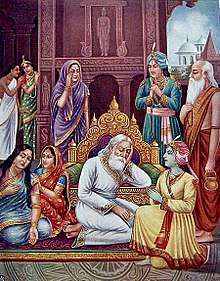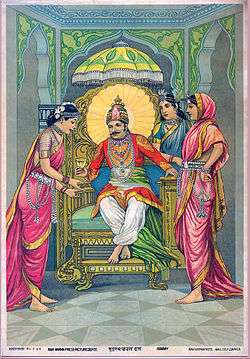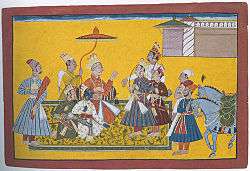Dasharatha
Dasharatha was a descendant of the Raghuvanshi-Ikshvaku-Suryavansha dynasty and the Maharaja of Koshala Kingdom as mentioned in the Hindu epic, the Ramayana. His capital was known as Ayodhya.
| Dasharatha | |
|---|---|
| Maharaja of Kosala | |
 King Dasharatha grieves inconsolably at his obligation to banish Rama to the forest | |
| Maharaja of Kosala | |
| Predecessor | Aja |
| Successor | Rama |
| Born | Ayodhya,India |
| Died | Ayodhya, Kosala (present-day Uttar Pradesh, India) |
| Consort(s) | Kausalya Kaikeyi Sumitra |
| Issue | Rama Bharatha Lakshmana Shatrughna Shanta |
| Dynasty | Raghuvanshi-Ikshvaku-Suryavanshi |
| Father | Aja |
| Mother | Indumati |
| Religion | Hinduism |
Dasharatha was the son of Aja and Indumati. He had three wives; Kausalya, Kaikeyi and Sumitra and out of the union born Rama (One of Vishnu's most popular incarnations), Bharata, Lakshmana and Shatrughna. King Dasharatha was incarnation of Dronavasu Brahmin, who received a boon from Lord Vishnu in his first life in Satya Yuga.
Early life
Dasharatha was the son of King Aja of Ayodhya and Princess Indumati of Vidarbha. His birth name was Nemi, but he acquired the name Dasharatha as his chariot could move in all ten directions, fly as well as come down on earth and he could fight with ease in all these directions.
Dasharatha became the King after his parents died. He was a great warrior who single-handedly conquered the whole earth with his prowess and defeated and slew many Asuras in war.
Dasharath had three queen consorts, namely, Kaushalya, Sumitra and Kaikeyi. Kaushalya was from the Kingdom of Magadha. Sumitra was from Kashi. Kaikeyi was from Kekeya Kingdom. Having an immense desire to beget a son, Dasharath promised Kaikeyi that the son she bore would succeed him as King of Ayodhya after she pleaded with him in the Kop Bhavan.
Yajña to beget sons

Dasharath performed a yajña with the help of Sage Rishyasringa on the advice of Vasishtha.
The Yajña was the Putra-kameshti at the bank of Manorama river. Dasharath and Kaushalya had a daughter Shanta, who was Rishyashringa's wife. As the conclusion of the Yagna drew near, Agni sprang out from the Yagnakunda (sacrificial fire pit) and handed Dasharatha a pot of kheer (payasa), advising him to distribute it among his queens.
Kaushalya ate half the kheer, Sumitra ate a quarter of the kheer. Kaikeyi ate some and passed the pot back to Sumitra who consumed the kheer for the second time.

Thus the queens conceived after the consumption of the kheer. Since Kaushalya had consumed the largest portion she gave birth to Rama. Kaikeyi gave birth to Bharata. Sumitra, who had consumed the kheer twice, gave birth to Lakshmana and Shatrughna.The part Sumitra took from Rani Kaushalya resulted in birth of Lakshmana,close to Rama. The part Sumitra took from Kaikeyi resulted in birth of Sharrughana, close to Bharata.
Killing of Shravan Kumara
After Rama's departure to the forest, Dasharatha lies in his bed with a wailing Kaushalya. He suddenly remembers an incident which had occurred in the past. He narrates to Kaushalya about how, by accident, he had killed a young boy named Shravana mistaking him to be an elephant. Dasharatha who was then a crown prince had gone hunting on the banks of River Saryu. He was an expert in hunting by determining the direction of sound and heard the gurgle of an animal drinking water. Mistaking it to be water flowing through the trunk of an elephant, Dasharatha shot an arrow. He became mortified when he heard a human cry as the arrow found its target. Dasharatha hurried there to find a boy lying sprawled on the banks of the river with an arrow lodged in his chest. The boy forgives Dasharatha for his unintentional unrighteous act and demands that he pull the arrow out of his chest. He also tells him to take the pitcher of water to his blind parents who must be waiting for him. The boy dies. Dasharatha approaches the blind couple and tells them about their son's unfortunate death. The parents, grief-stricken curse the prince: "Just as we are dying due to the separation from our beloved son, you too shall have the same fate." Dasharatha concludes the chapter by saying that his end is near and the curse has taken effect. The place where Dasharatha killed Shravana is now known as Shravan Kshetra.[1]

Portrayals Of Dashrath In Mass Media
Dasharath has been portrayed by several actors in different television adaptations of Ramayana:
| Year | TV Series | Channel | Country | Played by |
|---|---|---|---|---|
| 1987–1988 | Ramayan (TV series) | DD National | India | Bal Dhuri |
| 1997-2000 | Jai Hanuman (1997 TV series) | DD Metro | India | Deep Dhillon |
| 2000 | Vishnu Puran | Zee TV | India | Rishabh Shukla |
| 2002 | Ramayan (2002 TV series) | Zee TV | India | Gajendra Chauhan |
| 2008–2009 | Ramayan (2008 TV series) | NDTV Imagine | India | Pankaj Kalra |
| 2012–2013 | Ramayan (2012 TV series) | Zee TV | India | Rishabh Shukla |
| 2015–2016 | Siya Ke Ram | Star Plus | India | Dalip Tahil |
| 2019–2020 | Ram Siya Ke Luv Kush | Colors TV | India | Ankur Nayyar |
References
- "Lord Rama's father King Dasharatha was cursed by an old couple- Here's why". Zee News. 10 November 2016.
External links
| Wikimedia Commons has media related to Dasharatha. |
.jpg)